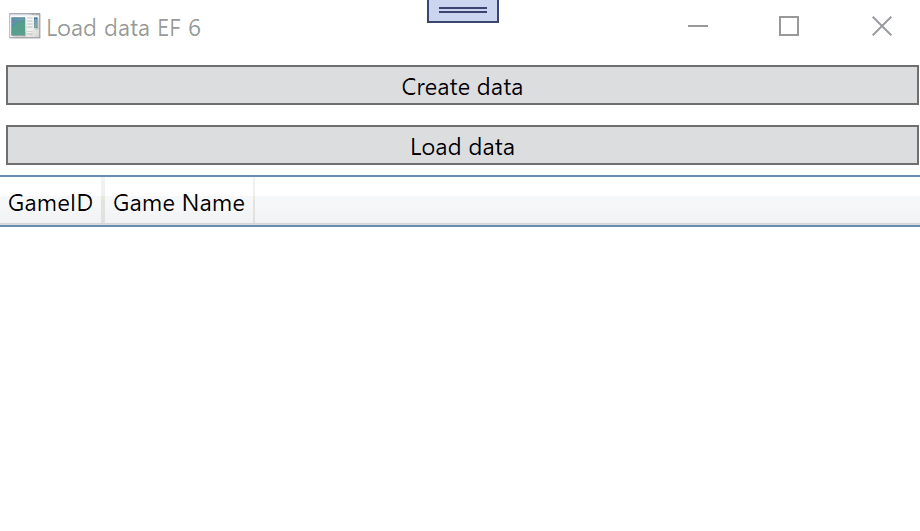2,854 questions
Hi,
try following demo:
XAML:
<Window x:Class="WpfApp1.Window043"
xmlns="http://schemas.microsoft.com/winfx/2006/xaml/presentation"
xmlns:x="http://schemas.microsoft.com/winfx/2006/xaml"
xmlns:d="http://schemas.microsoft.com/expression/blend/2008"
xmlns:mc="http://schemas.openxmlformats.org/markup-compatibility/2006"
xmlns:local="clr-namespace:WpfApp043"
mc:Ignorable="d"
Title="Load data EF 6" Height="450" Width="800">
<Window.DataContext>
<local:ViewModel/>
</Window.DataContext>
<StackPanel>
<Button Content="Create data" Command="{Binding Cmd}" CommandParameter="Create" Margin="5"/>
<Button Content="Load data" Command="{Binding Cmd}" CommandParameter="Load" Margin="5"/>
<DataGrid AutoGenerateColumns="False" ItemsSource="{Binding GameCollection}">
<DataGrid.Columns>
<DataGridTextColumn Header="GameID" Binding="{Binding GameID, Mode=OneWay}" Width="SizeToHeader" />
<DataGridTextColumn Header="Game Name" Binding="{Binding Name, Mode=OneWay}" Width="SizeToHeader"/>
</DataGrid.Columns>
</DataGrid>
</StackPanel>
</Window>
And classes:
using System;
using System.ComponentModel;
using System.Data;
using System.Data.SqlClient;
using System.Linq;
using System.Windows;
using System.Windows.Data;
using System.Windows.Input;
namespace WpfApp043
{
public class ViewModel :INotifyPropertyChanged
{
private CollectionViewSource cvs = new CollectionViewSource();
public ICollectionView GameCollection { get => cvs.View; }
public ICommand Cmd { get => new RelayCommand(CmdExec); }
private void CmdExec(object parameter)
{
switch (parameter.ToString())
{
case "Create":
CreateData();
break;
case "Load":
cvs.Source = from item in (new WpfApp1.Window043DBEntities1()).Game1.AsEnumerable() select item;
OnPropertyChanged(nameof(GameCollection));
break;
default:
break;
}
}
private void CreateData()
{
using (SqlConnection cn = new SqlConnection(WpfApp1.Properties.Settings.Default.cnSQL))
{
cn.Open();
using (SqlCommand cmd = new SqlCommand() { Connection = cn })
{
// delete previous table in SQL Server 2016 and above
cmd.CommandText = "DROP TABLE IF EXISTS Game1;";
//' delete previous table in versions
//cmd.CommandText = "If OBJECT_ID('Game1', 'U') IS NOT NULL DROP TABLE IF EXISTS Table1;"
cmd.ExecuteNonQuery();
// Create Tables
cmd.CommandText = "CREATE Table Game1([GameID] Integer Identity, [Name] nvarchar(50), CONSTRAINT [PK_Game1] PRIMARY KEY ([GameID]));";
cmd.ExecuteNonQuery();
// Insert data records
cmd.CommandText = "INSERT INTO Game1([Name]) VALUES('Game 1');INSERT INTO Game1([Name]) VALUES('Game 2');INSERT INTO Game1([Name]) VALUES('Game 3');";
cmd.ExecuteNonQuery();
}
}
}
#region INotifyPropertyChanged Members
public event PropertyChangedEventHandler PropertyChanged;
public void OnPropertyChanged(string propertyName) =>
PropertyChanged?.Invoke(this, new PropertyChangedEventArgs(propertyName));
#endregion
}
public class Game
{
public int GameID { get; set; }
public string Name { get; set; }
}
public class RelayCommand : ICommand
{
private readonly Predicate<object> _canExecute;
private readonly Action<object> _action;
public RelayCommand(Action<object> action) { _action = action; _canExecute = null; }
public RelayCommand(Action<object> action, Predicate<object> canExecute) { _action = action; _canExecute = canExecute; }
public void Execute(object o) => _action(o);
public bool CanExecute(object o) => _canExecute == null ? true : _canExecute(o);
public event EventHandler CanExecuteChanged
{
add { CommandManager.RequerySuggested += value; }
remove { CommandManager.RequerySuggested -= value; }
}
}
}
Result:

